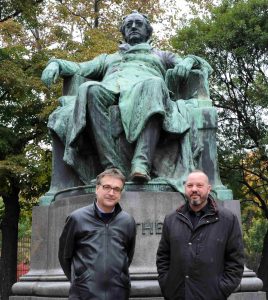“Science is thrilling and fun, you just need the right attitude”, Thomas Hofmann and Mathias Harzhauser argue and emphasize in their recently published book “Haie, Goethe und die Gurken”, showing a weird, unconventional, interdisciplinary and authentic potpourri of Vienna in 15 walks through the city.
The final event of the Vienna March for Science on April 22 at Maria-Theresien-Platz will be a ‘radiate’ party thanks to it’s location, as you may read in the chapter Wien strahlt (Radiant Vienna) in Hofmann and Harzhauser’s book “Haie, Goethe und die Gurken”. The Bohemian hornblende-granite at the 19 meters central monument has a natural radioactivity of 0,2 microsievert an hour, the stairs out of Mauthausner granite from Enghagen even have 0,3 microsievert an hour. Such measurements are critical if measured in closed spaces over a longer period. But record-breaking is the base of Goethe’s statue, a Syenite (plutonic rock) from Piemont, with 0,76 microsievert per hour. Therefore, the authors suggest: “You should not get too comfortable and arrange yourself homely there.”

Foto: Schumacher / NHM
